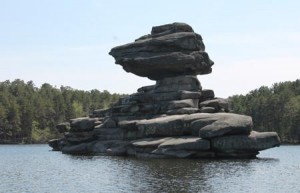 A recent press tour of the Shchuchinsk-Borovoye resort organised to promote tourism in Astana provided an opportunity for media representatives to visit the natural oasis and see the construction financed by the Department of Presidential Affairs of Kazakhstan taking place there.
A recent press tour of the Shchuchinsk-Borovoye resort organised to promote tourism in Astana provided an opportunity for media representatives to visit the natural oasis and see the construction financed by the Department of Presidential Affairs of Kazakhstan taking place there.
The government is looking to further develop the country’s tourism potential as part of its Kazakhstan 2020 development programme. Kazakhstan 2020 further defines comprehensive measures for the creation of five national tourist clusters. The Shchuchinsk-Borovoye resort area, which is becoming a centre of large scale tourism and cultural and recreational trips for both Kazakhstan and foreign nationals, is one of the most dynamic points of growth in Astana’s tourism industry.
According to government data, in recent years, revenue from tourism in Kazakhstan has grown. In 2008, the state earned about 66 billion tenge in tourism revenues; in 2009 this figure had reached 82 billion tenge. Tourism revenue stabilised in subsequent years. Private investment played a considerable role in this increase. Entrepreneurs are investing in the construction of athletic, touristic, cultural and recreational facilities.
Tourism development experience gained from other countries shows the importance of government participation in developing tourism infrastructure. Malaysia, for example, looking at the experience of Thailand and Singapore, which annually are visited by about 15 million tourists that bring 5 percent to 10 percent of their total national income, began to develop this industry in earnest.
The Malaysian government implemented a range of measures to encourage foreign tourists to visit. One of the main conditions of this policy was the construction of not only better infrastructure, but also a culture that supports tourism through teaching tourism sector employees courtesies and etiquette. Thanks to improved infrastructure and the cross cultural competence of the Malaysian tourism industry, the country now receives 25 million tourists a year from around the world. This gives the Malaysian economy much more substance than it had only a few short years ago. It is estimated that every tourist who visits the country injects $1,500 into the economy.
Meanwhile, in recent years, 100,000 to 300,000 local and foreign tourists have arrived at the Shchuchinsk-Borovoye resort during the summer. At that, the Borovoye zone accounts for the bulk of Kazakhstan’s visitors, which imposes a significant burden on infrastructure and natural resources. The Department of Presidential Affairs needs to build its infrastructure properly in order to evenly distribute the flow of tourists and vacationers around the perimetre of the resort zone, its officials say. Their action plan entails the development of three main leisure zones for travelers on the shores of Lake Schyuchye, Borovoye, Big Chebachye and Small Chebachye.
In previous years, a number of construction projects were implemented at Lake Shchuchye, including 14.3 kilometres of water supply lines, 28 kilometres of sanitation networks, over 5 kilometres of power lines and 9.4 kilometres of telephone lines. A two-year-old entertainment complex called Lapland next to the Rixos Hotel has become a favourite get away for children in the wintertime. This wonderful wooden palace, built in Finnish style with gabled towers and spires, hosts big winter celebrations and big shows hosted by none other than Santa Claus and the Snow Queen along with other characters. In addition, there are crystal palaces and ice rinks around the castle.
On the shore of the lake today, there are three rental outlets for sports equipment such as skates, skis, bicycles and other equipment for leisure sports.
Engineering infrastructure will also be built in the Borovoye zone, particularly 32 and 40 kilometres of water and sewer networks respectively and 18 kilometres of pedestrian and bicycle paths. In the future, when roads are connected to other areas of the park, their total length will reach 27.5 kilometres. Then, it is planned to build a sports and entertainment centre there with an indoor water park. It is being designed to accommodate visitors of all ages year round. The coast of the two other lakes, Big and Small Chebachye, will soon be transformed too.
Deputy Manager of the Department of Presidential Affairs Malik Murzalin said that today these lakes are very popular among lovers of water sports and swimming. In the future, the government will be looking to attract private investors. Big businesses with deeper pockets will be involved in the construction of campsites, mountain skiing bases, medical rehabilitation centres and sports complexes, including yacht clubs and boat-rowing stations. For these investors, land will be leased out for terms of 49 years.
In general, judging by the pace and scale of work carried out at the park, in the near future, the tourist potential of Shchuchinsk-Borovoye resort area will become fully developed; this will likely secure its position as a top ecotourism spot.
Burabai National Park is unique not only for its blue lakes, which reflect nearby ridges and picturesque rocks, but also for its rich fauna. The park has a very dedicated and sophisticated staff devoted to breeding and maintaining it. It is responsible for the herds of spotted, red and roe deer and families of wild boar, marmots and other animals that call the 140 hectare park home.

